An official website of the United States government
 United States Department of Labor
United States Department of Labor
Set up, operate, or tend wood sawing machines. May operate computer numerically controlled (CNC) equipment. Includes lead sawyers. Workers who primarily program or operate CNC equipment are classified in "Computer Numerically Controlled Tool Operators and Programmers" (51-9160).
Employment estimate and mean wage estimates for Sawing Machine Setters, Operators, and Tenders, Wood:
| Employment (1) | Employment RSE (3) |
Mean hourly wage |
Mean annual wage (2) |
Wage RSE (3) |
|---|---|---|---|---|
| 48,400 | 2.5 % | $ 16.01 | $ 33,290 | 0.6 % |
Percentile wage estimates for Sawing Machine Setters, Operators, and Tenders, Wood:
| Percentile | 10% | 25% | 50% (Median) |
75% | 90% |
|---|---|---|---|---|---|
| Hourly Wage | $ 10.42 | $ 12.72 | $ 15.17 | $ 18.76 | $ 23.12 |
| Annual Wage (2) | $ 21,680 | $ 26,450 | $ 31,560 | $ 39,010 | $ 48,080 |
Industries with the highest published employment and wages for Sawing Machine Setters, Operators, and Tenders, Wood are provided. For a list of all industries with employment in Sawing Machine Setters, Operators, and Tenders, Wood, see the Create Customized Tables function.
Industries with the highest levels of employment in Sawing Machine Setters, Operators, and Tenders, Wood:
| Industry | Employment (1) | Percent of industry employment | Hourly mean wage | Annual mean wage (2) |
|---|---|---|---|---|
| Sawmills and Wood Preservation | 17,730 | 19.91 | $ 16.35 | $ 34,010 |
| Other Wood Product Manufacturing | 11,680 | 5.12 | $ 15.05 | $ 31,300 |
| Veneer, Plywood, and Engineered Wood Product Manufacturing | 6,080 | 7.59 | $ 16.20 | $ 33,700 |
| Furniture and Related Product Manufacturing (3371 and 3372 only) | 4,260 | 1.29 | $ 16.12 | $ 33,520 |
| Merchant Wholesalers, Durable Goods (4232, 4233, 4235, 4236, 4237, and 4239 only) | 2,800 | 0.20 | $ 15.74 | $ 32,740 |
Industries with the highest concentration of employment in Sawing Machine Setters, Operators, and Tenders, Wood:
| Industry | Employment (1) | Percent of industry employment | Hourly mean wage | Annual mean wage (2) |
|---|---|---|---|---|
| Sawmills and Wood Preservation | 17,730 | 19.91 | $ 16.35 | $ 34,010 |
| Veneer, Plywood, and Engineered Wood Product Manufacturing | 6,080 | 7.59 | $ 16.20 | $ 33,700 |
| Other Wood Product Manufacturing | 11,680 | 5.12 | $ 15.05 | $ 31,300 |
| Logging | 820 | 1.72 | $ 17.88 | $ 37,190 |
| Furniture and Related Product Manufacturing (3371 and 3372 only) | 4,260 | 1.29 | $ 16.12 | $ 33,520 |
Top paying industries for Sawing Machine Setters, Operators, and Tenders, Wood:
| Industry | Employment (1) | Percent of industry employment | Hourly mean wage | Annual mean wage (2) |
|---|---|---|---|---|
| Pulp, Paper, and Paperboard Mills | 290 | 0.32 | $ 22.27 | $ 46,320 |
| Other Specialty Trade Contractors | (8) | (8) | $ 20.34 | $ 42,300 |
| Building Finishing Contractors | 120 | 0.02 | $ 19.69 | $ 40,960 |
| Nonmetallic Mineral Product Manufacturing | 70 | 0.02 | $ 19.27 | $ 40,080 |
| Fabricated Metal Product Manufacturing (3321, 3322, 3325, 3326, and 3329 only) | 60 | 0.01 | $ 17.95 | $ 37,340 |
States and areas with the highest published employment, location quotients, and wages for Sawing Machine Setters, Operators, and Tenders, Wood are provided. For a list of all areas with employment in Sawing Machine Setters, Operators, and Tenders, Wood, see the Create Customized Tables function.
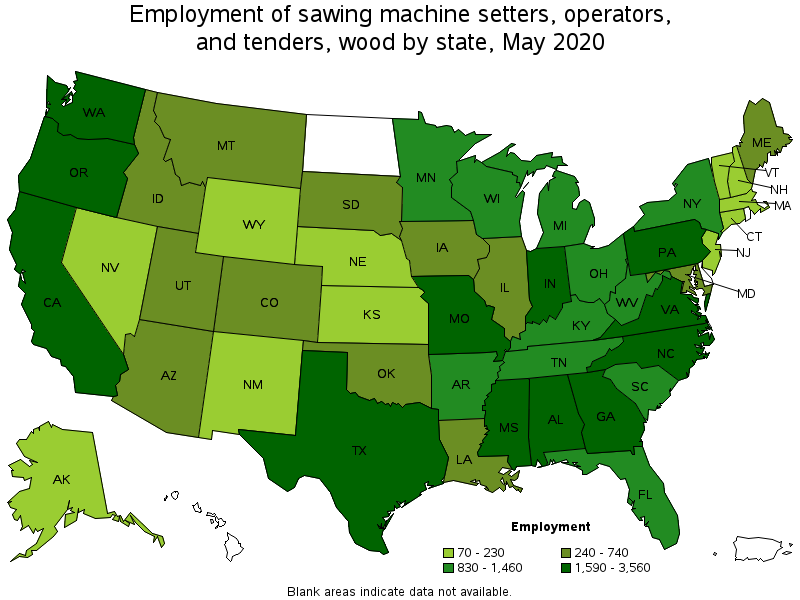
States with the highest employment level in Sawing Machine Setters, Operators, and Tenders, Wood:
| State | Employment (1) | Employment per thousand jobs | Location quotient (9) | Hourly mean wage | Annual mean wage (2) |
|---|---|---|---|---|---|
| Texas | 3,560 | 0.29 | 0.85 | $ 12.52 | $ 26,030 |
| North Carolina | 2,980 | 0.69 | 2.00 | $ 15.41 | $ 32,050 |
| Oregon | 2,840 | 1.57 | 4.52 | $ 18.93 | $ 39,380 |
| Georgia | 2,740 | 0.64 | 1.83 | $ 14.78 | $ 30,730 |
| California | 2,530 | 0.15 | 0.44 | $ 16.65 | $ 34,630 |
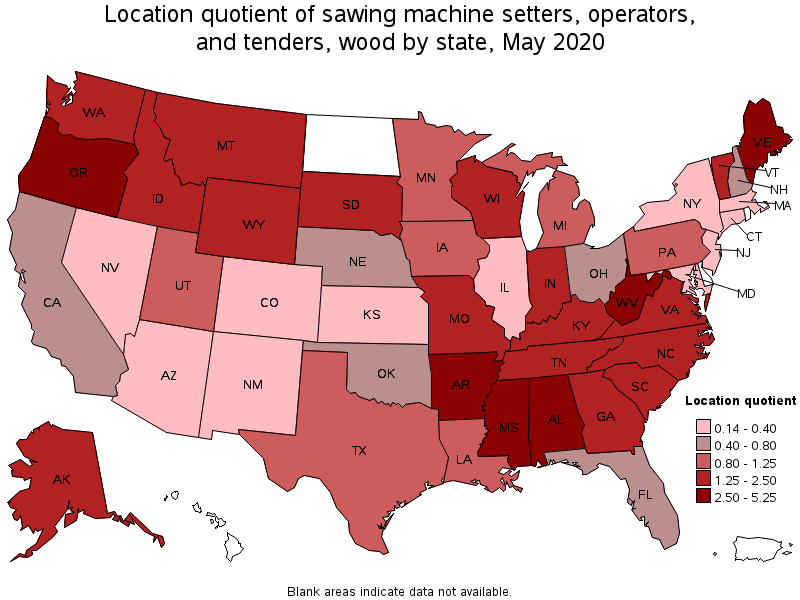
States with the highest concentration of jobs and location quotients in Sawing Machine Setters, Operators, and Tenders, Wood:
| State | Employment (1) | Employment per thousand jobs | Location quotient (9) | Hourly mean wage | Annual mean wage (2) |
|---|---|---|---|---|---|
| Mississippi | 1,970 | 1.83 | 5.25 | $ 14.81 | $ 30,800 |
| Oregon | 2,840 | 1.57 | 4.52 | $ 18.93 | $ 39,380 |
| West Virginia | 830 | 1.27 | 3.65 | $ 15.17 | $ 31,540 |
| Alabama | 2,370 | 1.24 | 3.57 | $ 14.31 | $ 29,770 |
| Arkansas | 1,210 | 1.03 | 2.95 | $ 14.78 | $ 30,740 |
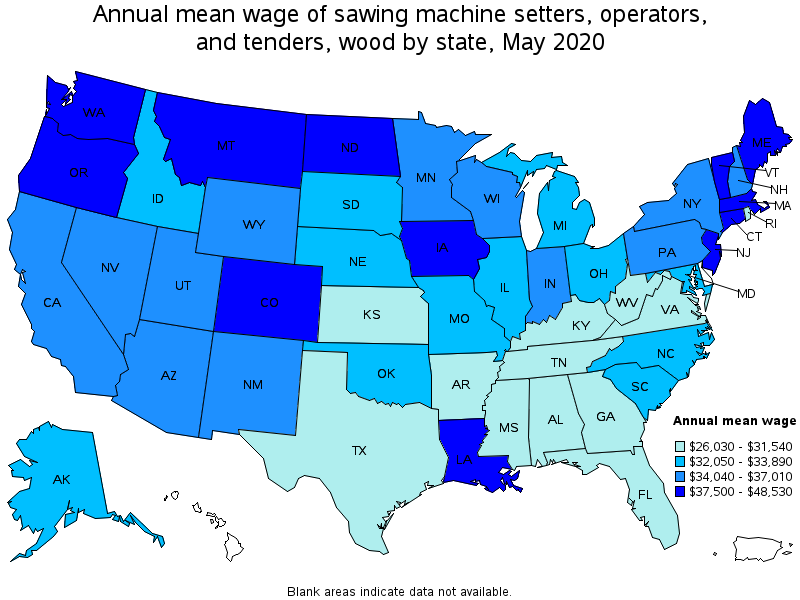
Top paying states for Sawing Machine Setters, Operators, and Tenders, Wood:
| State | Employment (1) | Employment per thousand jobs | Location quotient (9) | Hourly mean wage | Annual mean wage (2) |
|---|---|---|---|---|---|
| North Dakota | (8) | (8) | (8) | $ 23.33 | $ 48,530 |
| Montana | 240 | 0.52 | 1.50 | $ 21.68 | $ 45,100 |
| Connecticut | 80 | 0.05 | 0.14 | $ 21.36 | $ 44,430 |
| Washington | 1,680 | 0.53 | 1.51 | $ 20.22 | $ 42,060 |
| Vermont | 150 | 0.53 | 1.53 | $ 19.95 | $ 41,490 |
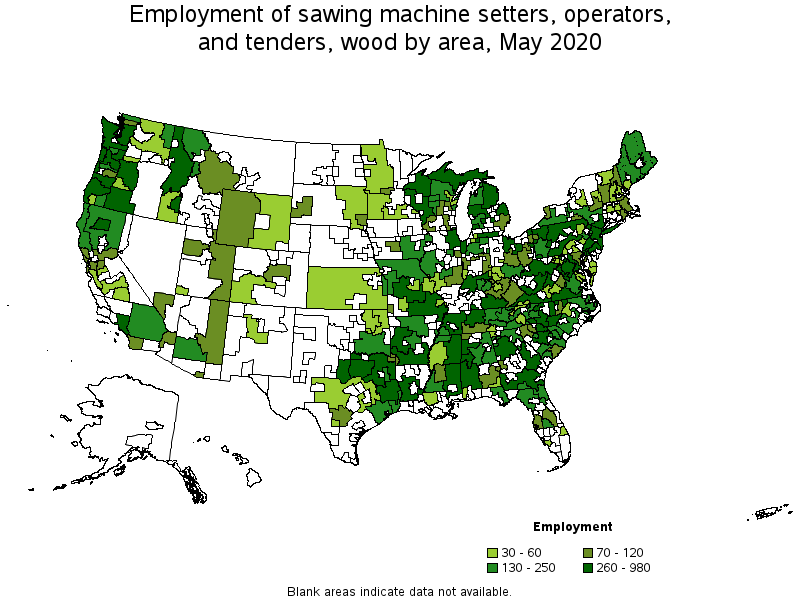
Metropolitan areas with the highest employment level in Sawing Machine Setters, Operators, and Tenders, Wood:
| Metropolitan area | Employment (1) | Employment per thousand jobs | Location quotient (9) | Hourly mean wage | Annual mean wage (2) |
|---|---|---|---|---|---|
| Dallas-Fort Worth-Arlington, TX | 980 | 0.27 | 0.79 | $ 13.18 | $ 27,420 |
| Portland-Vancouver-Hillsboro, OR-WA | 980 | 0.85 | 2.46 | $ 18.03 | $ 37,510 |
| Atlanta-Sandy Springs-Roswell, GA | 690 | 0.26 | 0.75 | $ 15.47 | $ 32,170 |
| Los Angeles-Long Beach-Anaheim, CA | 640 | 0.11 | 0.32 | $ 16.38 | $ 34,070 |
| Tuscaloosa, AL | 500 | 4.94 | 14.21 | $ 13.35 | $ 27,770 |
| Charlotte-Concord-Gastonia, NC-SC | 490 | 0.40 | 1.16 | $ 18.04 | $ 37,520 |
| Greensboro-High Point, NC | 470 | 1.35 | 3.89 | $ 13.34 | $ 27,740 |
| Elkhart-Goshen, IN | 460 | 3.67 | 10.54 | $ 17.45 | $ 36,300 |
| Seattle-Tacoma-Bellevue, WA | 450 | 0.23 | 0.66 | $ 20.28 | $ 42,180 |
| Eugene, OR | 380 | 2.57 | 7.39 | $ 19.62 | $ 40,810 |
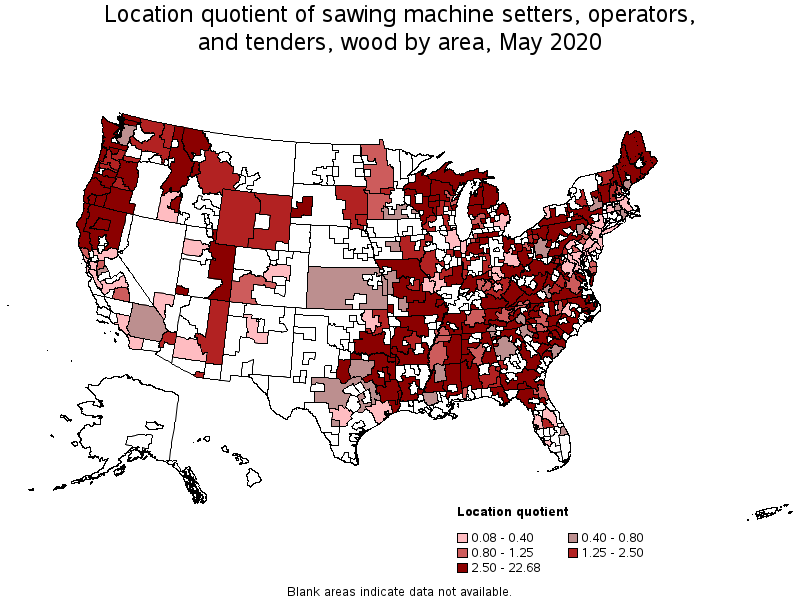
Metropolitan areas with the highest concentration of jobs and location quotients in Sawing Machine Setters, Operators, and Tenders, Wood:
| Metropolitan area | Employment (1) | Employment per thousand jobs | Location quotient (9) | Hourly mean wage | Annual mean wage (2) |
|---|---|---|---|---|---|
| Tuscaloosa, AL | 500 | 4.94 | 14.21 | $ 13.35 | $ 27,770 |
| Redding, CA | 260 | 4.13 | 11.86 | $ 16.31 | $ 33,920 |
| Longview, WA | 140 | 3.84 | 11.03 | $ 21.05 | $ 43,780 |
| Elkhart-Goshen, IN | 460 | 3.67 | 10.54 | $ 17.45 | $ 36,300 |
| Mount Vernon-Anacortes, WA | 120 | 2.68 | 7.70 | $ 17.71 | $ 36,840 |
| Eugene, OR | 380 | 2.57 | 7.39 | $ 19.62 | $ 40,810 |
| Wausau, WI | 170 | 2.51 | 7.23 | $ 16.78 | $ 34,910 |
| Valdosta, GA | 130 | 2.50 | 7.18 | $ 16.56 | $ 34,440 |
| Albany, OR | 100 | 2.33 | 6.70 | $ 20.76 | $ 43,190 |
| Florence, SC | 190 | 2.24 | 6.44 | $ 15.43 | $ 32,090 |
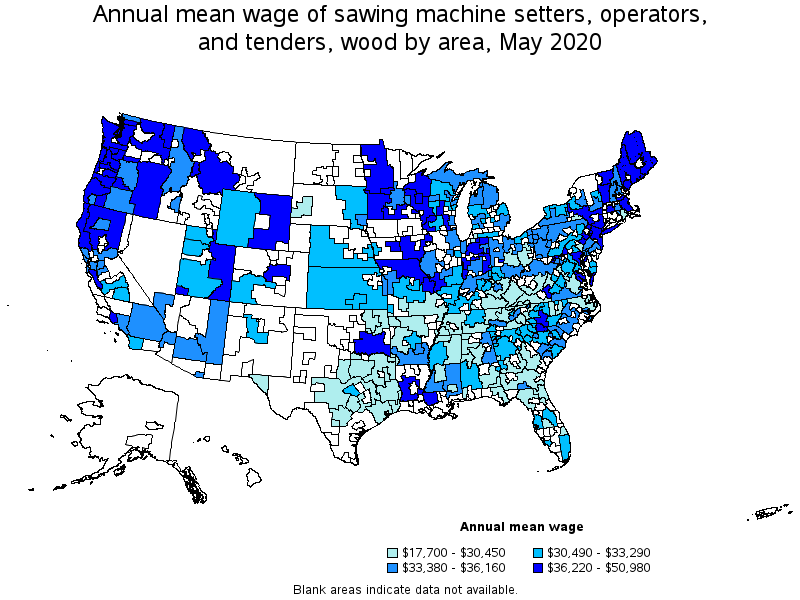
Top paying metropolitan areas for Sawing Machine Setters, Operators, and Tenders, Wood:
| Metropolitan area | Employment (1) | Employment per thousand jobs | Location quotient (9) | Hourly mean wage | Annual mean wage (2) |
|---|---|---|---|---|---|
| San Jose-Sunnyvale-Santa Clara, CA | 30 | 0.03 | 0.08 | $ 22.39 | $ 46,570 |
| St. Louis, MO-IL | 60 | 0.05 | 0.14 | $ 22.00 | $ 45,760 |
| St. George, UT | 60 | 0.90 | 2.59 | $ 21.95 | $ 45,660 |
| Terre Haute, IN | 30 | 0.50 | 1.45 | $ 21.28 | $ 44,260 |
| Longview, WA | 140 | 3.84 | 11.03 | $ 21.05 | $ 43,780 |
| Boston-Cambridge-Nashua, MA-NH | 110 | 0.04 | 0.12 | $ 21.01 | $ 43,700 |
| Albany, OR | 100 | 2.33 | 6.70 | $ 20.76 | $ 43,190 |
| Medford, OR | 150 | 1.74 | 5.00 | $ 20.32 | $ 42,260 |
| Seattle-Tacoma-Bellevue, WA | 450 | 0.23 | 0.66 | $ 20.28 | $ 42,180 |
| Portland-South Portland, ME | 50 | 0.27 | 0.79 | $ 20.27 | $ 42,170 |
Nonmetropolitan areas with the highest employment in Sawing Machine Setters, Operators, and Tenders, Wood:
| Nonmetropolitan area | Employment (1) | Employment per thousand jobs | Location quotient (9) | Hourly mean wage | Annual mean wage (2) |
|---|---|---|---|---|---|
| Northeast Mississippi nonmetropolitan area | 740 | 3.30 | 9.49 | $ 13.74 | $ 28,570 |
| South Central Kentucky nonmetropolitan area | 710 | 4.47 | 12.84 | $ 13.30 | $ 27,670 |
| Big Thicket Region of Texas nonmetropolitan area | 660 | 6.36 | 18.29 | $ 11.78 | $ 24,510 |
| South Georgia nonmetropolitan area | 610 | 3.27 | 9.41 | $ 14.23 | $ 29,590 |
| Southeast Missouri nonmetropolitan area | 570 | 3.53 | 10.15 | $ 14.64 | $ 30,450 |
Nonmetropolitan areas with the highest concentration of jobs and location quotients in Sawing Machine Setters, Operators, and Tenders, Wood:
| Nonmetropolitan area | Employment (1) | Employment per thousand jobs | Location quotient (9) | Hourly mean wage | Annual mean wage (2) |
|---|---|---|---|---|---|
| Southwest Alabama nonmetropolitan area | 510 | 7.89 | 22.68 | $ 15.79 | $ 32,840 |
| Northwest Alabama nonmetropolitan area | 470 | 7.31 | 21.00 | $ 14.01 | $ 29,130 |
| Central Oregon nonmetropolitan area | 410 | 7.10 | 20.41 | $ 17.07 | $ 35,510 |
| Northwestern Idaho nonmetropolitan area | 470 | 7.00 | 20.12 | $ 16.42 | $ 34,160 |
| Big Thicket Region of Texas nonmetropolitan area | 660 | 6.36 | 18.29 | $ 11.78 | $ 24,510 |
Top paying nonmetropolitan areas for Sawing Machine Setters, Operators, and Tenders, Wood:
| Nonmetropolitan area | Employment (1) | Employment per thousand jobs | Location quotient (9) | Hourly mean wage | Annual mean wage (2) |
|---|---|---|---|---|---|
| Northern Vermont nonmetropolitan area | 40 | 0.60 | 1.72 | $ 24.51 | $ 50,980 |
| West Montana nonmetropolitan area | 130 | 1.76 | 5.05 | $ 23.06 | $ 47,960 |
| Western Washington nonmetropolitan area | 450 | 3.79 | 10.90 | $ 22.58 | $ 46,970 |
| Coast Oregon nonmetropolitan area | 450 | 4.26 | 12.24 | $ 21.95 | $ 45,660 |
| Northwest Minnesota nonmetropolitan area | 60 | 0.35 | 0.99 | $ 21.08 | $ 43,840 |
These estimates are calculated with data collected from employers in all industry sectors, all metropolitan and nonmetropolitan areas, and all states and the District of Columbia. The top employment and wage figures are provided above. The complete list is available in the downloadable XLS files.
The percentile wage estimate is the value of a wage below which a certain percent of workers fall. The median wage is the 50th percentile wage estimate—50 percent of workers earn less than the median and 50 percent of workers earn more than the median. More about percentile wages.
(1) Estimates for detailed occupations do not sum to the totals because the totals include occupations not shown separately. Estimates do not include self-employed workers.
(2) Annual wages have been calculated by multiplying the hourly mean wage by a "year-round, full-time" hours figure of 2,080 hours; for those occupations where there is not an hourly wage published, the annual wage has been directly calculated from the reported survey data.
(3) The relative standard error (RSE) is a measure of the reliability of a survey statistic. The smaller the relative standard error, the more precise the estimate.
(8) Estimate not released.
(9) The location quotient is the ratio of the area concentration of occupational employment to the national average concentration. A location quotient greater than one indicates the occupation has a higher share of employment than average, and a location quotient less than one indicates the occupation is less prevalent in the area than average.
Other OEWS estimates and related information:
May 2020 National Occupational Employment and Wage Estimates
May 2020 State Occupational Employment and Wage Estimates
May 2020 Metropolitan and Nonmetropolitan Area Occupational Employment and Wage Estimates
May 2020 National Industry-Specific Occupational Employment and Wage Estimates
Last Modified Date: March 31, 2021